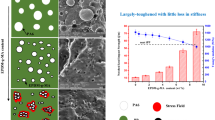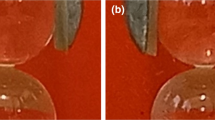Abstract
In this paper the common degradation effect of silicon oxide filler on fracture strain and fracture toughness of isotactic polypropylene is investigated by analysing the failure processes in the composite material by microscopic methods. Experiments demonstrate that, although fracture of the polymer regions absorbs considerable energy by plastic deformation, void formation and cracking of the interface between the polymer and the filler usually requires very little energy. These weak interfaces do not resist cracking and are the cause of brittleness in particulate filled systems. The crucial parameters influencing the fracture data of the composite were found to be the volume fraction of the filler and the interfacial adhesion between polymer matrix and particles. As the interfacial fracture energy is usually much smaller than the polymer fracture energy, the composite toughness drops when filler is added. Using a model which describes the individual steps of crack formation and final fracture, an attempt is made to explain the decrease of crack resistance of the polymer matrix with increasing filler fraction and to calculate the fracture energy of the composite by introducing partial values of crack resistance of the matrix and the interface, respectively. In addition, it is discussed how a coarse spherulitic morphology of the matrix, as produced by isothermal crystallization from the melt, can modify this behaviour.
Similar content being viewed by others
References
M. O. W. Richardson, “Polymer Engineering Composites,” (Applied Science Publishers, Ltd, London, 1977).
H. S. Katz and J. V. Milewski, “Handbook of Fillers and Reinforcements for Plastics,” (Van Nostrand Reinhold, Wokingham, 1978).
M. Arina, A. Honkanen and V. Tammela, Polymer Eng. Sci. 19 (1979) 30.
S. J. Monte, G. Sugerman and D. J. Seeman, “Titanate Coupling Agents-Current Applications,” presented at a meeting of the Rubber Division American Chemical Society, Chicago, Illinois, May 1977. (Published in Bulletin No. KR-0577-6, Kenrich Petrochemicals, Inc., Bayonne, New Jersey).
K. Friedrich, Progr. Colloid Polymer Sci. 66 (1979) 299.
Idem, ibid. 64 (1978) 103.
J. G. Williams, Imperial College, London, private communication, 1977.
K. V. Gotham, Plastics Polymers 12 (1973) 273.
M. Parvin and J. G. Williams, Int. J. Fract. 11 (1975) 963.
H. G. Schrader, PhD Thesis, Institute of Materials Science, Ruhr-Universität Bochum, Germany, 1979.
L. M. Brown and J. D. Embury, Proceedings of the 3rd International Conference on Strength of Metals and Alloys, Paper 33, Cambridge, UK 1973 (Institute for Metals and the Iron and Steel Institute, London) p. 164.
H. H. Kausch, “Polymer Fracture,” (Springer Verlag, New York, 1978).
E. Hornbogen and K. Friedrich, J. Mater. Sci. 9 (1980) 2175.
K. Kendall, Brit. Polymer J. 10 (1978) 35.
Author information
Authors and Affiliations
Rights and permissions
About this article
Cite this article
Friedrich, K., Karsch, U.A. Failure processes in particulate filled polypropylene. J Mater Sci 16, 2167–2175 (1981). https://doi.org/10.1007/BF00542377
Received:
Accepted:
Issue Date:
DOI: https://doi.org/10.1007/BF00542377




